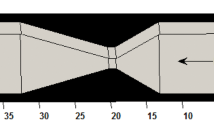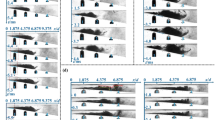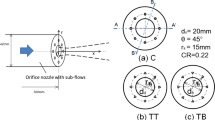Abstract
The effects of auxiliary flow tube vent opening area and arrangement on the gas flow field as a gas propelled cylinder exits a flow tube were studied numerically. Configurations with a single opening of increasing size and multiple opening arrangements with equivalent opening area were considered for comparison to a baseline no-opening system. The openings are positioned near the end of the flow tube. The intended use of the openings is to reduce the pressures of the gases escaping to the surroundings and thus to reduce the intensity and size of the gas expansion zone in the surroundings. The results indicated that increasing the opening flow area decreased the pressure at the axial end of the flow tube and the radial extent of the end of flow tube exit plume. However, the radially directed flow streams leaving through the side vent openings could increase the overall radial spread of the gas expansion into the surroundings. The single opening arrangement produced as much as a 95% decrease in the pressure at the end of the flow tube and a 37% decrease in the recoil force at a given time with about 95% of the exiting flow leaving through the opening. For the parameters considered, the multiple opening arrangement produced up to a 93% decrease in the pressure at the end of the flow tube and a 90% decrease in the recoil force at a given time with about 93% of the exiting flow leaving through the openings. The results showed larger single openings to be more effective at reducing end of flow tube pressure, while the multiple openings to be more conducive to a reduced recoil force.
Similar content being viewed by others
Abbreviations
- d :
-
diameter of flow tube (m) (Fig. 1)
- F press :
-
pressure force (N) (Eq. 5)
- F res :
-
resistance force (N) (Eq. 5)
- F viscous :
-
viscous force (N) (Eq. 5)
- F tube :
-
force acting on the flow tube in the negative x direction
- G,Y,S:
-
turbulence parameters (Eq. 4)
- h :
-
enthalpy (J/kg) (Eq. 3)
- k gas :
-
thermal conductivity of gas (W/mK) (Eq. 3)
- m c :
-
mass of propelled cylinder (kg) (Eq. 5)
- ol :
-
length of opening (m) (Fig. 1)
- p :
-
pressure (Pa) (Eq. 3)
- P init :
-
initial gas pressure acting on moving cylinder (Pa)
- t :
-
time (s)
- T :
-
temperature (K)
- T init :
-
initial gas temperature acting on moving cylinder (K) (Fig. 1)
- ν :
-
fluid velocity vector (m/s) (Eqs. 1–4)
- V c :
-
instantaneous velocity of moving cylinder (m/s) (Eq. 5, Fig. 1)
- x,y:
-
coordinates
- α :
-
angle of flow stream with x (flow tube) axis (Eq. 6)
- ε :
-
turbulence parameter (Eq. 4b)
- κ :
-
turbulence parameter (Eq. 4a)
- ρ :
-
gas density (kg/m3)
- τ :
-
stress tensor (Eq. 2)
- τ′:
-
stress tensor (Eq. 3)
- μ :
-
fluid viscosity
- c :
-
related to moving cylinder (Fig. 1a)
- ref :
-
reference values used for normalizing data presented
- Δ:
-
difference
- 1,2,3:
-
reference to the opening number for particular arrangement
- e :
-
reference to end of flow tube
References
Cler DL et al (2003) Computational fluid dynamics application to gun muzzle blast a validation case study. ARCCB-TR-03011
Jiang Z et al. (2004) Shocked flow induced by supersonic projectiles moving in tubes. Comput Fluids 33:953–966
May IW, Einstein SI (1980) Prediction of gun muzzle flash. ARBRL-TR-02229
Schmidt E (1981) Secondary combustion in gas exhaust flows. ARBRL-TR-02373
Klingenberg G, Heimerl JM (1992) Gas muzzle blast and flash. In: Seebass AR (ed) Progress in astronautics and aeronautics, vol 139. AIAA, Washington
Carfagno SP (1961) Handbook on gun flash. Franklin Institute report AD327051
Keller GE (1983) The effect of propellant composition on secondary muzzle blast overpressure. AEBRL-MR-03260
Baur EH, Ford JC (1991) A parametric study of muzzle devices for small caliber automatic rifles. BRL_TR-3234
Baur EH, Schmidt EM (1986) Candidate muzzle devices for the improved M16. BRL-MR-3513
Wang JCT, Widhope GF (1990) Numerical simulation of blast flowfields using a high resolution TVD finite volume scheme. Comput Fluids 18:103–137
Kim HD et al. (2003) A study of the impulsive wave discharged from the inclined exit of a tube. Proc Inst Mech Eng Part C, J Mech Eng Sci 217:271–279
Liang S-M, Liao C-Y (2007) Blast-wave dynamics in a circular duct with a sudden expansion. AIAA J 45:2164–2173
Jiang X et al. (2008) Numerical simulation of blast flow fields induced by high speed projectile. Shock Waves 18:205–212
Jiang X et al. (2008) Numerical investigations on dynamic process of muzzle flow. Appl Math Mech 29:351–360
Ponyavin V, Chen Y, Pepper D, Hsieh H-T Numerical modeling of unsteady flow around the projectile in the light gas gun. IMECE2004-59640, Anaheim, CA
Ponyavin V et al, Calculation of unsteady gas flow around a projectile moving through a gun barrel. IMECE2003-41930, Washington, DC
de Bues T et al, 2-D H adaptive Finite element method for gas gun design. IMECE2003-41929, Washington, DC
Dayan Y, Touati D (2006) Simulation of unsteady muzzle flow of a small caliber gun. In: Rahman M, Brebbia CA (eds) Advances in fluid mechanics VI. WIT Press, pp 165–171
Fluent 6.3 Users Guide (2006)
Patankar SV (1980) Numerical heat transfer and fluid flow. Hemisphere, New York
VanDoormaal JP, Raithby GD (1984) Enhancements of the SIMPLE method for predicting incompressible fluid flows. Numer Heat Transfer 7:147–163
Shyy W et al. (1997) Computational techniques for complex transport phenomenon. Cambridge University Press, New York
Shih T-H et al. (1995) A new k-e eddy-viscosity model for high Reynolds number turbulent flows—model development and validation. Comput Fluids 24:227–238
Kim SE et al (1997) Computations of complex turbulent flows using the commercial code FLUENT. In: Proceedings of the ICASE/LARC/AFOSR symposium on modeling complex turbulent flows, Hampton, VA
Wilcox DC (2006) Turbulence modeling for CFD. DCW Industries, Inc, La Canada
Sarkar S, Balakrishnan L (1990) Application of a Reynolds-stress turbulence model to the compressible shear layer, compressibility affects turbulence through so-called “dilatation dissipation”. ICASE report 90-18 NASA-CR 18202
Lixing Z (1993) Theory and numerical modeling of turbulent gas-particle flows and combustion. CRC Press, Boca Raton
Liou MS, Steffen CJ (1993) A new flux splitting scheme. J Comput Phys 107:23–29
Johnston Ian A (2005) The Noble Abel equation of state: thermodynamic derivations for ballistics modeling. DSTO-TN-0670
Gerber N (1971) Sensitivity study of rifle gas systems. BRL 1524
White FM (1991) Viscous fluid flow. McGraw Hill, New York
Author information
Authors and Affiliations
Corresponding author
Rights and permissions
About this article
Cite this article
Florio, L.A. Effect of vent opening area and arrangement on gas flow field as gas propelled cylinder exits a flow tube. Meccanica 45, 475–501 (2010). https://doi.org/10.1007/s11012-009-9266-3
Received:
Accepted:
Published:
Issue Date:
DOI: https://doi.org/10.1007/s11012-009-9266-3




